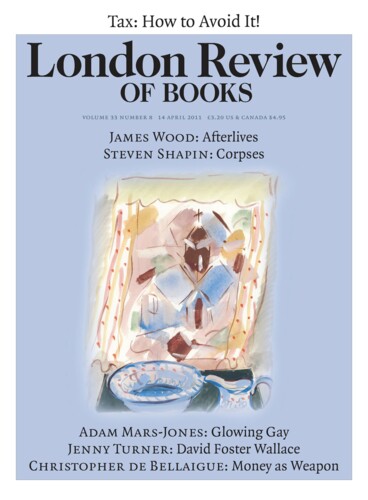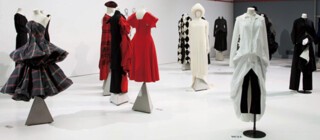In a big rectangular gallery at the V&A (until 10 July) 63 dummies stand in loose groups, males labelled with an M and a number, females with a W. Each supports a garment designed between 1983 and 2011 by Yohji Yamamoto. You wander among them like a guest at a party, a garden party perhaps: the light is clear and bright. You can get as close as you like to examine fabric and stitching and to look at backs and fronts. There are frocks and jackets, shirts, skirts, shifts, suits and coats showing an astonishing variety of techniques, materials, influences and inventions. There is nothing of the shop window about the arrangement. Yamamoto has reservations about museum installations but I have never been among garments mounted on mannequins that felt so alive and so strongly suggested absent bodies.
Of all the pictures in the book that accompanies the exhibition, one of a young gypsy wearing a loose jacket, high-waisted trousers and a white collarless vest says most about Yamamoto’s use of sources. It is his favourite photograph, one of the studies of German types made by August Sander in the 1920s and 1930s, which have been a regular inspiration. The young man, his hair long, his face narrow and handsome, seems to be entirely at home with his body and the clothes that hang easily on it. Yamamoto, whose clothes sometimes offer a similar ease, has said of vintage clothes that it is the passage of time that makes them perfect. Perfect in the way time has adapted them to a body, not in immaculate finish.
Fashion, like architecture, shapes materials to protect us. Take W23: long black silk dress with button-down sides. It hangs straight; the long rows of small, black, almost-touching buttons that hold it together – like, but also very unlike, Versace’s gold safety pins – reveal almost nothing. It is a discreet, sober dress. It also makes you smile. On the whole these garments offer women’s bodies refuges, not ways of displaying themselves. Those in stiff felt stand firm – who knows where and how they would touch the body? Some materials are strange: a long red coat in matted, boiled wool; many are unusually tough, the kind of cotton military uniforms are made of; there are emphatic hound’s-tooth check tweeds, and frocks in cotton gabardine. There is a lot of black. Puffs and swathes of fabric make trains and bustles; scarves are built into shirts. Nothing, no collar, no skirt, is quite symmetrical.
Being in the business of looking at art puts you at a disadvantage here. Like the V&A’s Diaghilev exhibition, this one brings you close to objects which were, and should always be, part of a performance – at the very least the performance of being worn. But their past has been more dramatic than that. Masao Nihei, who has organised lighting for Yamamoto, writes of fashion shows in the 1980s and 1990s in which audience and cast were melded, the former taking parts like princes and princesses in 17th-century court masques: ‘Attracted by the creative spirit of these fashion designers, many artists and members of the film, music, dance and theatre communities took part in their shows … musicians of diverse genres – jazz, punk and gypsy – were regulars at Yohji’s shows.’
Though ‘essentially a business situation for buyers and the press’, Nihei writes, for a while fashion shows allowed a ‘previously unseen beauty’ to emerge. We must guess at these performances when turning to the costumes: first for themselves, as works of high craft, and then for what they say about our relation to the layers of fabric that protect us from the weather and attract or deny the eyes of others. The models in the video displays don’t strut or sashay; Yamamoto addresses the private woman: ‘For me, a woman who is absorbed in her work, who does not care about gaining one’s favour, strong yet subtle at the same time, is essentially more seductive. The more she hides and abandons her femininity, the more it emerges from the very heart of her existence.’
Yet there are garments here that wow you in quite another way. Take W22: grey, white and pink checks, strapless top and skirt with crinoline – silk and metal. The skirt, somehow supported in potato-crisp curves, is a static appendage, not a kindly protection or a flowing addition. An illustration shows its perky sculptural firmness exhibited alongside architectural work by Frank Gehry and others in a previous museum installation. To dress a body, it is clear, demands disciplines that Gehry’s architectural inventions can afford to ignore.
Fashion, like fiction and popular music, offers selves to identify with. Through it standard dress – the lounge suits worn by heads of state, for example – can be made to escape a dispiriting denial of individuality. The loose pleated trousers and suit jackets that had lost their tapered waists, linings and padding in Yamamoto’s Autumn/Winter 1985 collection have been described by the scholars as a redefinition of ‘male clothing forms’. Yet that look itself became stereotypical, as Ligaya Salazar, the show’s curator, points out: ‘Yamamoto’s new menswear silhouette – loose dark suit jacket, wide trousers and white T-shirt – became almost a uniform for the well-dressed man in the creative industries in the 1980s and 1990s.’ In the interesting period when a look is new, but before it settles into being smart, to wear it is to take a small risk – that of looking silly or eccentric – and a possible reward: of looking distinctly yourself.
There are photographs from collection catalogues, in particular those by Max Vadukul, in which models walk the streets and share the frame with passers-by. In one, a girl in a black jacket with a white lining and white trousers does a little springbok leap in the air: the homburg-hatted businessman in front of her doesn’t notice. In images like this new kinds of clothes seem to infiltrate crowds like exotic species.
Send Letters To:
The Editor
London Review of Books,
28 Little Russell Street
London, WC1A 2HN
letters@lrb.co.uk
Please include name, address, and a telephone number.


